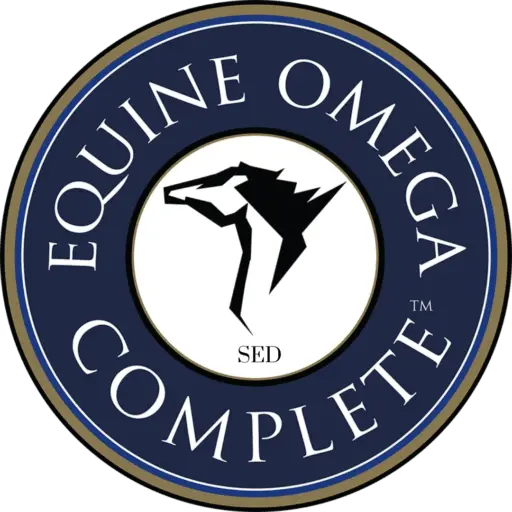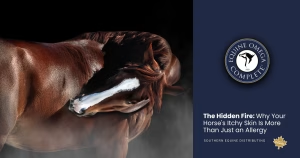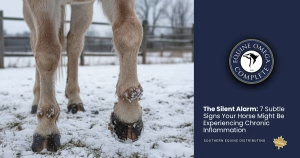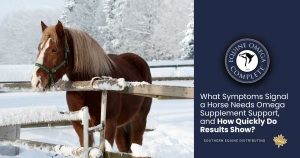Studies on EOC® as a Horse Ulcer Treatment
At Southern Equine Distributing, we stand behind our products. We truly believe that Equine Omega Complete® is the best choice for horses of all kinds, of all ages, and of all disciplines. In particular, we believe that EOC® is the best choice for horses suffering from reduced joint mobility due to age, injury, and inflammation and horses suffering from common digestive issues such as stomach ulcers.
Horses involved in competitive sports and fed grain diets are at higher risk for developing gastric ulcers due to increased acid production. Ulcers can form in different areas of the stomach, including the upper squamous tissue (squamous ulcers), the pylorus (pyloric ulcers), and the lower glandular portion (glandular ulcers). Traditional treatments can be time-consuming, costly, and challenging to administer correctly, leading many horse owners to seek more effective solutions.
The downside of traditional treatments
Traditional treatments for all types of gastric ulcers can be time-consuming depending on the location and severity of the ulcer and are costly to the horse owner. They are challenging to carry out according to instructions which often require the stomach to be empty and the treatment administered 30 minutes or more before food is given. This can be particularly difficult for owners who board their horses.
Additionally, there is always a risk that ulcers can return. Whether it’s a horse’s nervous personality, an inability to deal with stress, or need to be on other medications that increase the risk of ulcers, many owners will likely treat ulcers more than once during their horse’s life, repeating the costly, time-consuming process.
Studies on improving protection from ulcers
Studies have documented the positive effects of long-chain omega fatty acids in reducing the prevalence and severity of squamous gastric ulcers in exercised Thoroughbreds (Pagan et al., 2002). This research supports previous findings that short- and long-chain polyunsaturated fats, present in EOC®, play a crucial role in regulating the inflammatory response and promoting ulcer healing. Previous studies looked at:
- Supplements that strengthen the tissue of the stomach to improve its resistance to ulceration;
- Supplements that buffer stomach acid to reduce the risk of this acidity; and
- Coating agents that cover the tissue to create a barrier against erosion
1. Pagan, J. D., Hauss, A. A., Pagan, E. C., Simons, J. L., & Waldridge, B. M. (2002). Long-chain polyunsaturated fatty acid supplementation increases levels in red blood cells and reduces the prevalence and severity of squamous gastric ulcers in exercised Thoroughbreds, Journal of American Veterinary Medical Association, 260(S3), S121-S128.
Equine Omega Complete and Glandular Ulcers
Glandular ulcers are more challenging to treat due to their continuous exposure to stomach acid. However, research shows that polyunsaturated fats, like those contained in EOC®, have the potential to effectively treat these difficult ulcers. A recent study published in the Journal of American Veterinary Medical Association showed that administering polyunsaturated fat (such as those contained in Equine Omega Complete®’s patented blend) to horses with squamous ulcers – and the more difficult glandular ulcers – showed healing within just 14 days.
One can see that Equine Omega Complete®’s patented blend of omega-3 and omega-6 fatty acids can aid in treating all three types of ulcers while reducing the healing period by up to 75 percent.
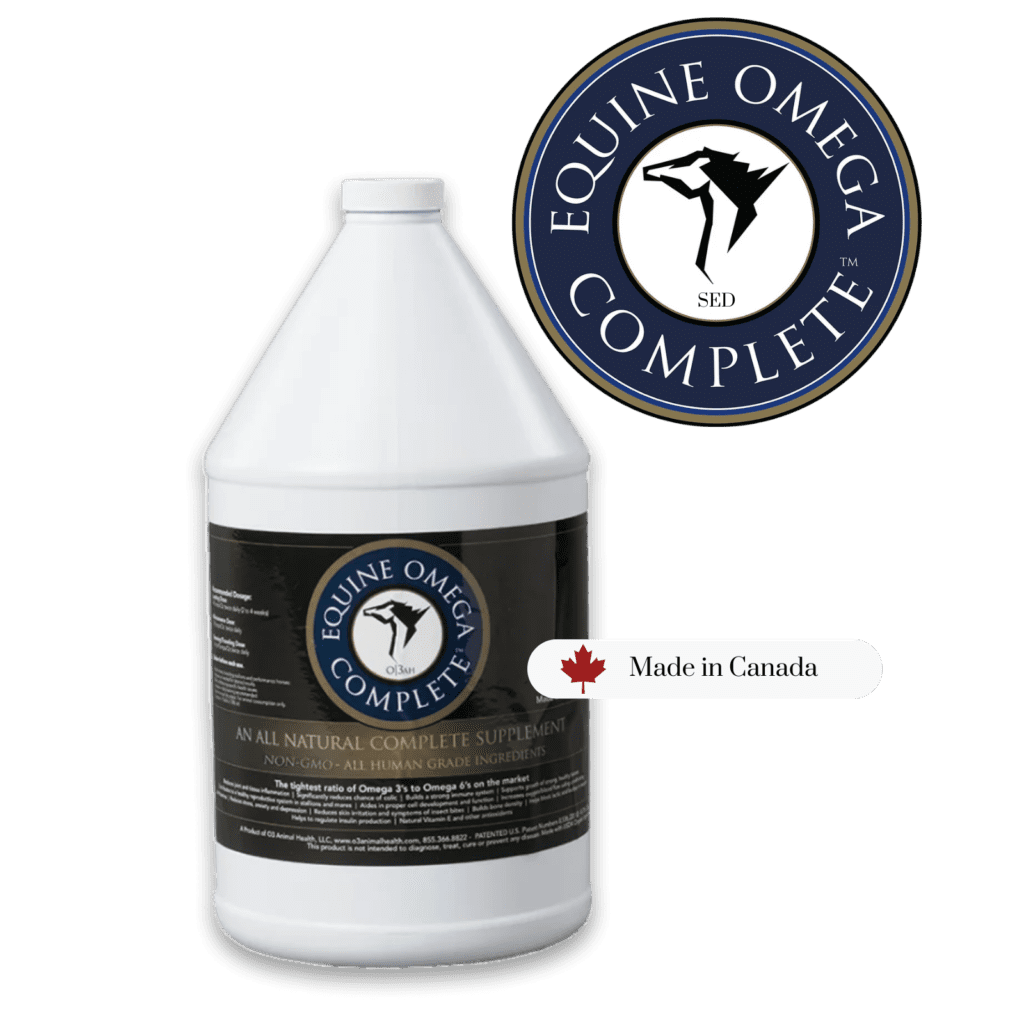
Equine Omega Complete
This blend of DHA and EPA essential omega fats and natural antioxidants supports inflammatory response, performance recovery, insulin regulation, and weight management while ensuring strong hooves and a radiant coat. Equine Omega Complete® is a unique blend of organic soybean oil, wild-caught fish oil and all-natural vitamin E.
The importance of EOC's patented blend of polyunsaturated fatty acids (PUFAs)
Equine Omega Complete® contains a patented blend of polyunsaturated fatty acids, including omega-3 and omega-6, derived from non-GMO soy oil. Research recently published in the Journal of the American Veterinary Medical Association shows that horses supplemented with EOC®’s blend of long-chain polyunsaturated fatty acids reduced severe ulcer prevalence by up to 30 percent compared to the control horses (notation 2).
2. IBID.

Case studies on the effects of EOC® in horses with ulcers
Horse One: 13-year-old Warmblood Gelding
Horse One was diagnosed with pyloric ulcers and placed on 4oz of Equine Omega Complete® twice a day for 4 weeks and rescoped. His pyloris was found to be improved, and while not yet completely healed, his attitude was reported to have returned to normal without a relapse to his prior anxious, neurotic behaviour that was occurring prior to starting the oil.
Further gastroscopy one month later revealed no active ulcers at the pylorus with only a slightly thickened glandular fold, and the previous lesion appeared stable and inactive.
Horse Two: 11-year-old Warmblood Mare
Horse Two presented with recurrent squamous gastric ulcers and mild colic. After treatment for a month with Gastrogard, the squamous ulcers had resolved, but the pyloric inflammation remained. She was placed on 2 oz of Equine Omega Complete® twice daily for a month with no further Gastrogard in the hopes of keeping the squamous ulcers from returning and resolving the pyloric inflammation.
When scoped one month later, no squamous ulcers were found, and the previous pyloric inflammation had also resolved.
Horse Three: 8-year-old Warmblood Gelding
Horse Three was diagnosed with Grade 2 Squamous ulcers and Grade 1 glandular ulcers. He was given 3 oz of Equine Omega Complete® twice a day for a month and reevaluated. His owners reported that while he was still kicking out to the leg in canter, this behaviour had resolved in walk and trot.
A second gastroscopy revealed that the squamous ulcers had fully resolved, and only focal acute glandular erosion was visible. The vet stated that the significance of this erosion was questionable, but Horse Three has remained on the Equine Omega Complete® for another month and will be re-scoped shortly.
All three horses showed favourable responses to the Equine Omega Complete®. Case studies are ongoing but combined with the research published on the benefits of long and short-chain polyunsaturated fats in supporting gastric health in horses; this product appears to provide excellent support for gastric health and regulating other inflammatory processes faced by today’s sport horses.
Those needing higher levels of vitamin E will find all the same benefits of polyunsaturated in Equine Omega Vitamin E®.

Equine Omega Complete
This blend of DHA and EPA essential omega fats and natural antioxidants supports inflammatory response, performance recovery, insulin regulation, and weight management while ensuring strong hooves and a radiant coat. Equine Omega Complete® is a unique blend of organic soybean oil, wild-caught fish oil and all-natural vitamin E.
